Cucugnan and the Pregnant Virgins
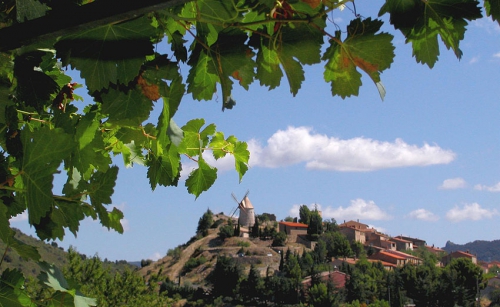
The picturesque village of Cucugnan is situated on the D14 road from Tuchan to Bugarach in the Corbieres between the Mediterranean coast and the High Valley of the River Aude. In high summer you have to park at the bottom of the hill and walk up into the village, which is fun, with gift-shops and restaurants galore. The houses in medieval style cling to the hillside. There is a theatre dedicated to its famous playwright, Achilles Mir, and a restored working windmill on the hill above, which inspired, they say, the “Lettres de mon Moulin” of Alphonse Daudet, in whose memory they have a story-telling week every July.
The very name, ending in “-an” inspires one to think the village was of Roman origin.
Very little has been discovered but at a place called La Vignasse, a bit to the west of Cucugnan, was found a gallo-Roman site, with rooftiles, pottery, iron nails and oyster shells, this last a sure sign of Roman occupation for the Romans loved oysters and just tossed away the shells wherever they were eating! Paul Courrent the historian wrote in 1935; Alongside the road from Tuchan to Rennes-les-Bains, has been discovered tombs with stone slabs, of which the reckoning makes us date these tombs from the Gallo-Roman period to the Visigothic period. So it’s likely that this was the place where Mary and Jesus stayed on their journey way back in summer 33AD. In those days hotels as we know them today did not exist; one stayed at the houses of friends of friends.
Queribus Castle
Two kilometres to the south of Cucugnan is the Cathar castle of Queribus, balanced on the top of needle-like rocks. You have to park below it, a picnic spot is there, and then walk for ten minutes to the castle. The view is breathtaking from this “eagle’s nest,” look round the circle of the Mediterranean sea to the east, the Pyrenees to the south, the Corbières and Bugarach to the west. There are mysteries concerned with Queribus; for example, the French writer Fernand Niel wrote that Queribus, and the castle of Montségur, were both solar temples. . . . the inner hallway, with its strangely positioned pillar, implies a “solar clock” based on the Zodiac.
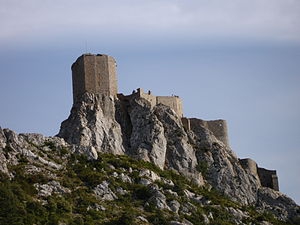
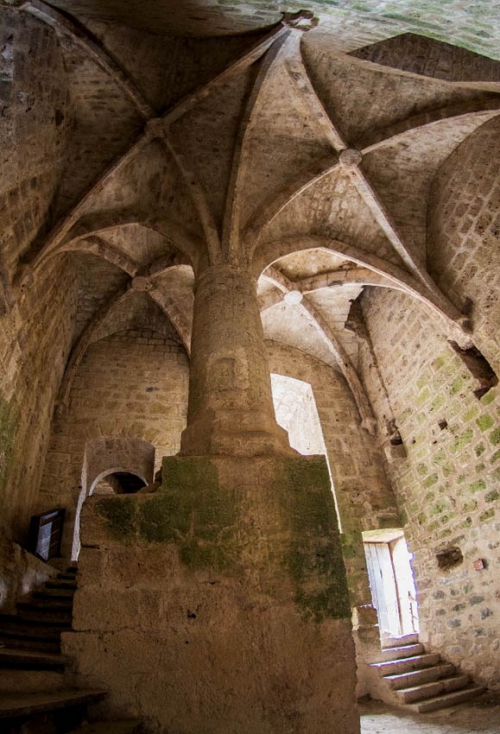
Queribus has been well-preserved by the local community. It includes a chapel, renovated in 1404 which was still in use in 1689, for the priest of Cucugnan was also the châtelain of the castle. He charged a special price for mass on the chapel’s saints day. Which saint? It was dedicated to St. Louis (King Louis IX) and it is bizarre to think Louis was made a saint by the Roman Church. The chapel was named after him in place where he had made war against the Cathars to raise money to go and kill the “Infidels”, in a castle that he had taken for his own possession.
After the fall of Montségur in 1244, this castle in the Corbières was used by the Cathars as a refuge on their way to Spain or Italy. Olivier de Termes negotiated for their final release in 1257, thirteen years after the taking of Montségur and the burning alive there of the Cathars. Catharism didn’t end then but the Inquisition focussed it’s efforts on capturing the Parfaits, for without them the religion would die out.
I often think the Cathar religion was the first Christianity. This was Christianity based on the teachings of Jesus. Mary Magdalene and Jesus had already come to the Corbières, eventually to Rennes-les-Bains, in effect a suburb of Narbonne. Mary was expecting his baby, but she baptised people and made them Christians. Jesus Christians.
The Cathars believed that Mary Magdalene and Jesus were married. Of all the faiths that the history books said imported Catharism into the south of France, not one of them believed that Mary Magdalene and Jesus were married. Only the Cathars have ever had this belief, of all the Christian style faiths in all the world. So where did this belief come from, how did it originate? There can be only one answer - grass roots. The Cathars of Aude, the Corbières and Ariège believed that Jesus and Mary were married because their ancestors living there in the first century had met Mary and Jesus as a couple.
You can see that Cathar beliefs stem from Christianity in the time of Jesus. The Cathars appeared in history about 1000AD, but they lived here in Languedoc from the time of Jesus himself and Mary Magdalene. You can read more by clicking here.
Something Unusual at Cucugnan
The church at Cucugnan is not very old. Up to the 19th century, the church rested on its own open ground, near the chateau, above the village, which implies it was originally a chapel for the château in Visigothic style. Open to all intemperate weather, the chapel decayed rapidly so it was destroyed and a church built in in a Neo-Gothic style in 1860, in its position today.
It is dedicated to St Julien et Ste Basilisse who were oriental, a “model couple’” rare in the list of saints - few are married couples. The church at Fitou village is also dedicated to them. This coincidence of dedications along the route hints that this route was once the border with Spain, where Julien and Basillisse are popular.
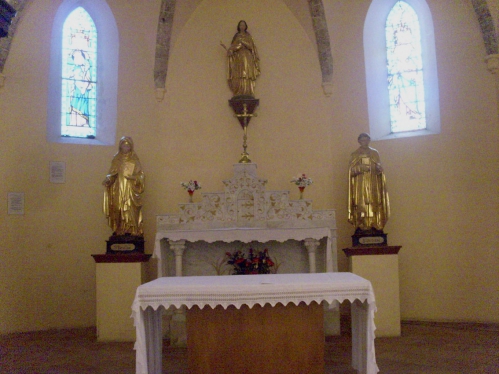
Saint Julien was born at Antioch in Syria, of Christian parents. At 18, his parents wanted him to marry. He considered this for a while and had a vision - he and his future wife would remain virgins. Everyone would admire their union. He agreed to marry Basilisse. On the evening of the marriage, she saw him at prayer and the room was full of the scent of flowers. Her husband explained to her how the flowers represented virginity, and she cheerfully consented to a virginal marriage of perfect continence.
They were soon rewarded, because a choir of saints, conducted by Jesus and his mother Mary appeared to them on a night brilliant with stars. The two entered a celestial harmony which filled their souls with inestimatable joy, says my saints book.
Their parents having died, they spent their inherited money on the relief of the poor and the sick; they made their house a hospital. They had separate lodgings for men and women, Basilisse cared for the women and Julien, whose immense kindness earned him the title of Hospitalier, took care of the men. Basilisse died first, after a celestial warning, and she predicted that her husband would soon receive a martyr’s palm.
Persecutions increased under Diocletian and Julien was thrown into prison. Even there, he made many conversions. Tortured by fire and wild beasts, he was then beheaded on 9 January 313. His tomb became famous for many miracles of healing; once, ten lepers were cured on the same day.
These saints became most popular in Spain, and so their influence spread north to the Corbières and are littered along the route that Mary Magdalene and Jesus took. This seems to be more than coincidence, for in a way Julien and Basilisse had a perfect marriage - as did Mary and Jesus?
Julien and Basilisse are the only male/female couple to be recognised as Saints in the Roman Church. There are churches to them at Barbaira, Belcaire, Bram, Brenac, Cascatel, Cucugnan, Espezel, Fitou, Fontcouverte, Limoux, Trèbes, Mouthoumet, Pomas, St. Julia le Bec near Quillan, and St Julien de Briole at Fanjeaux.
Back to Cucugnan
In this church at Cucugnan is more evidence that the old beliefs of the Cathars has somehow survived; a statuette in the church showing Mary Magdalene pregnant. Except they insist it is the Virgin and not Mary Magdalene.
She looks like Mary Magdalene to me. This little statuette is amazing. It is behind glass on the left-hand side as you approach the altar with its statues of St. Julien and Sainte Basilisse.
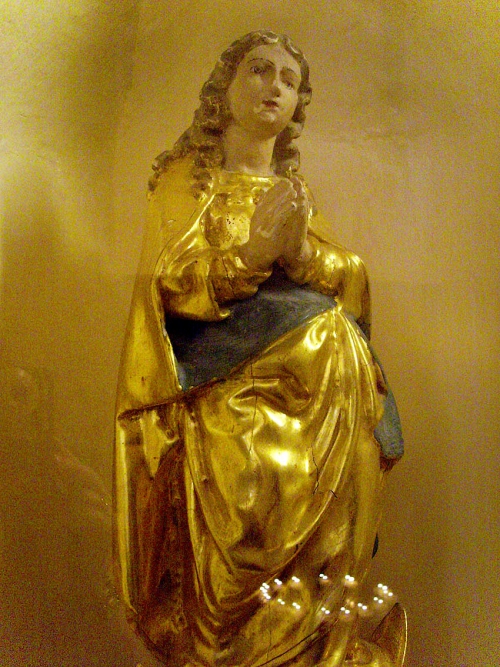
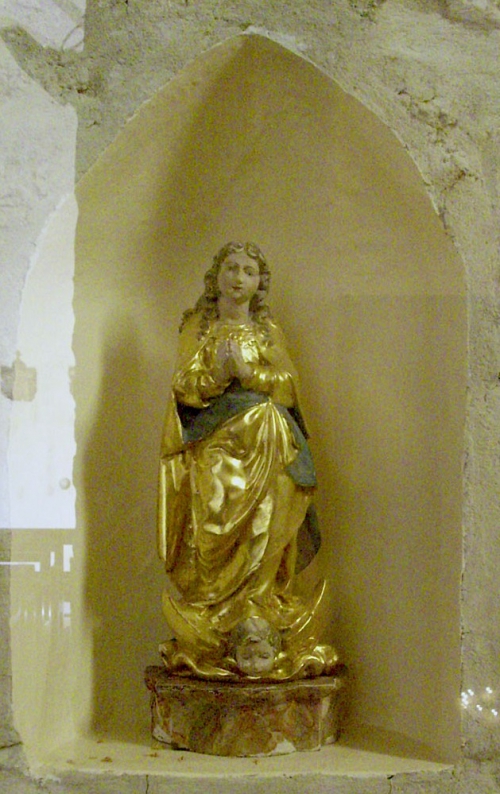
The “pregnant virgin” in gilded wood dates from the 17th century. It is 50cm high. She has on a gold robe and the cloth covering her bump is green. It’s origin is unknown but her unusualness led to several tribulations, especially after images of a pregnant virgin were forbidden by the Council of Trento, which made a list of all those images that should not appear in churches.
In 1930 the statue was moved to the Musée des Arts de Carcassonne, because, it’s said, of its specialness. Five years later, heavy hailstones battered Cucugnan. The inhabitants were thrown into a panic and demanded the return of their Virgin, but it took ten years before she returned in 1945, in the care of a young married woman who was the daughter of the mayor.
In 1958 the Cucugnan Pregnant Virgin went to Lourdes where was an exhibition of the Virgins of the Pyrenées to commemorate 100 years after “Our Lady” had been seen there. Then in 1981 the Virgin was stolen and completely by chance was found in the left-luggage office of Lille railway station!
Since then, she had always been behind a heavy glass screen in the church of Cucugnan, bringing the church good luck, except when she goes to special exhibitions. She was classified as an Historic Monument on the 25th February 1959.
They hesitate, this church says, to call it “sacred art,” it’s of interest to both the Christian and the atheist, and they would be delighted to hear of other pregnant virgins. I can tell them there is one in Provence that they have missed and there are more categories of belief than Christian and atheist!
The church people of Cucugnan believed for a long time that a statue such as this was very rare; but then talking to visitors showed there were other such statues scattered around France. Around 15 have been identified so far. Cucugnan claims they “have made an exhibition” of other pregnant virgins; this exhibition consisted of wall panels of pictures and information, there were no other statues or statuettes on display, but interesting nonetheless.
The official guide says; The statuette of the pregnant virgin of Cucugnan is in painted wood and dated the end of the 17th century. It is finely sculpted and drapped with a cloak falling in finely rendered folds. The Virgin holds her hands joined and supports her upper arms on her rounded stomach. Her left foot is resting on the head of an angel who lies on a segment of the moon. A snake crawls at her feet. It is the realistic work of an artist who translated the first verse of chapter 12 of Revelation.
Oh no, no, no it doesn’t! This verse in Revelation in the Bible says; Then a great and mysterious sight appeared in the sky. There was a woman, whose dress was the sun and who had the moon under her feet and a crown of twelve stars on her head.
There are no stars around the statuette’s head. The story continues in Revelation; She was soon to give birth and the pains and suffering of childbirth made her cry out. Another mysterious sight appeared in the sky. There was a huge red dragon with seven heads and ten horns and a crown on each of his heads. With his tail he drew a third of the stars out of the sky and threw them down to the earth. He stood in front of the woman, in order to eat her child as soon as it was born. Then she gave birth to a son, who will rule over all the nations with an iron rod. But the child was snatched away (from the dragon presumably) and taken to God and his throne. The woman fled to the desert, to a place God had prepared for her, where she will be taken care of for 1,260 days.
That number of days is three and a half years (although it sounds like a code to me.) This is repeated in verse 14, and then the chapter ends with; The dragon was furious with the woman and went off to fight with the rest of her descendants, all those who obey God’s commandments and are faithful to the truth revealed by Jesus.
The Book of Revelation consists of the visions that came to Lazarus, Mary Magdalene’s brother. Many conventional Roman Catholic people think the woman in this story was the Virgin Mary but they also believe she suffered no pain in childbirth because she had no original sin as did other women. So this story in Revelation doesn’t sound as though it’s about the Virgin Mary and bears no relationship to the story of her in the Gospels.
To me the word “descendants” gives it away. What descendants did the Virgin Mary have? In theory she remained perpetually virgin. And Jesus did too, according to the Church, he never married and never had children. So how could the woman have descendants? Also, how could the new born child the dragon tried to kill be Jesus when, the passage says, he already had descendants to whom he had revealed the truth?
There are many spiritual people who believe Mary Magdalene and Jesus married and had children. This woman in Revelations was Mary Magdalene, they tell us, and much of the book of Revelation is an encoded history of the children that Mary Magdalene and Jesus had together after he survived the crucifixion.
I am inclined to the same point of view.
And who could the “bridegroom” be but Jesus?
Some convoluted theology for you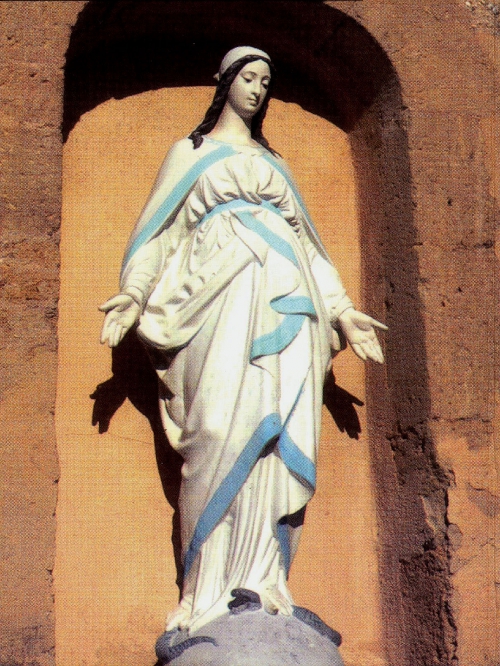
This pregnant virgin is installed in a niche on the church wall in the place de l'Eglise of the little village of Cornillon-Confoux, just to the north of St. Chamas, itself on the étang de Berre, just west of Marseille. Istres (named after Isis) is also on this étang, about 8 km away.
This picture appears in Provence Insolite et Secrète by Jean-Pierre Cassely. This statue once had 12 stars around her head, evoking the pregnant lady in Revelations, who many of us believe to have been Mary Magdalene.
The author tells us there are only 11 other pregnant virgins in the whole and France and these are at; Riems in Marne department, Brioude in Haute Loire, Plomeur in Finistere, Brittany, Chissey-sur-Loué in the Jura department, and Oulchy-le-Château in Aisne department. There's another at Arcachon. In our magical region of Languedoc pregnant virgins can also be seen at Laroque-des-Albères in the Pyrenees-Orientales, at Prades, also in Pyrenees-Orientales, at Perpignan, the capital of Pyrenées-Orientales, and at Belpech in Aude. And Cucugnac.
The subject of pregnant virgins is fascinating. The Church disapproves of these images or statuettes, although it says quite clearly in the Bible that the Virgin Mary had a baby in the usual way. Later a tradition developed, that because she had not had sex with anyone, the Virgin was pure, therefore she did not have to pay the price for original sin with all the other women in the world. She was not Eve, who tempted Adam into sin, she was pure and good, and so was not obliged to suffer the pain of childbirth. In the first century Roman world in which Mary lived were many stories of Gods being born to virgins, such as the emperor Augustus himself, who was deified even before his death.
The Bible’s stories of the start of Mary’s pregnancy are quite revealing. In St. Matthew it says quite simply that she “found out she was going to have a baby by the Holy Spirit.” Later (Matthew 1, 21) says “She will have a son, and you will name him Jesus - because he will save his people from their sins.” We don’t know who St. Matthew was but St. Paul, who never knew Jesus, was the author of this statement. He had never known Jesus and based all his passionate religion on a vision. John the Baptist and Jesus said nothing about dying on the cross to save sins, they believed in the ceremony of baptism where the sins were washed away from a willing adherent. (Click here for our article about the Baptist.) Paul was not logical. If Jesus had died to forgive us, we were forgiven already and had no need to go to confession, which the later Roman church delighted in, for they found out all the secrets of their members - who then had to pay the priest for forgiving them!
“Now all this happened,” continues Matthew, “in order to make what the Lord had said through a prophet come true.” He is at pains to prove the prophet and to explain that Jesus's mother was a virgin.
The Gospel of Mark tells us that John the Baptist was preaching and baptising, telling the people that if they were baptised, God would forgive their sins. There is no mention of a virgin birth. Mark was also a follower of St. Paul.
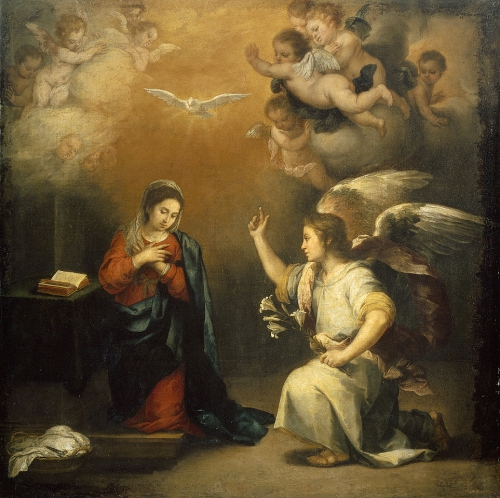
One day an angel came . . . Murillo 1680
Then we turn to Luke, who was a born novelist. He always embroidered his stories to make them more readable. Luke was a doctor who traveled with St. Paul and he too had never met Jesus that we know of. (I believe that many of his stories were accounts told to him by someone who had known Jesus and his family - see my article about Joanna here.) In his account the Angel Gabriel came to visit Mary and tell her of the great honour that God had made to her, for the Holy Spirit had given her a baby. It is unclear who was a descendant of David, but the implication was that Joseph was, for the Lord would make Jesus a king, as he had made David one.
Lastly, St. John’s Gospel does not mention a Virgin Birth, but he tells us a quite sophisticated bit of theology, with many hints about the mysticism that Mary Magdalene, Jesus and Lazarus persued. (I think Lazarus wrote this gospel.) This passage, John 1, 1 - 14 says; Some (of his own people) did receive him and believed in him; so he gave them the right to become God’s children. They did not become God’s children by natural means, that is, by being born as the children of a human father; God himself was their father. The Word became a human being and full of grace and truth lived among us. We saw his glory, the glory which he received as the Father’s only son. John (the baptist) spoke about him. He cried out; “This is the one I was talking about when I said, He comes after me, but he is greater than I am, because he existed before I was born.”
It seems to me they were talking about reincarnation, that the Church still disapproves of.
The Virgins!
I have some information and pictures, by no means complete, for those who would like to see the virgins for themselves. The pictures are not very good quality but the best I could find.
Brioude
In the Basilic St. Julian at Brioude, in the department of Haute Loire in Auvergne, the Virgin “Parturiente” is lying down; she is soon to give birth perhaps? It could be as old as 12th century. The Cathedral, Byzantine in style was built by the Visigothic king Euric in 480 over the grave of two martyrs Julien and Ferréol. You have to pay to go in. You can print out a guide to the cathedral here.
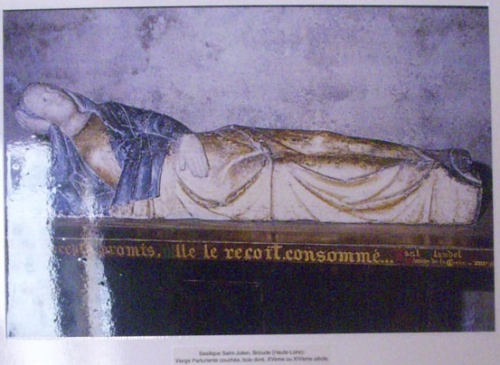
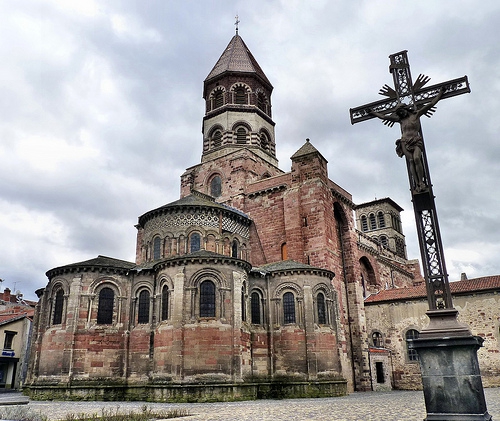
Plomeur
In Brittany, at Plomeur the Virgin’s full name is Notre Dame de l’Attente ou Notre Dame de l’Espérance - Our “Lady in Waiting” or “Our Lady in Hope.”
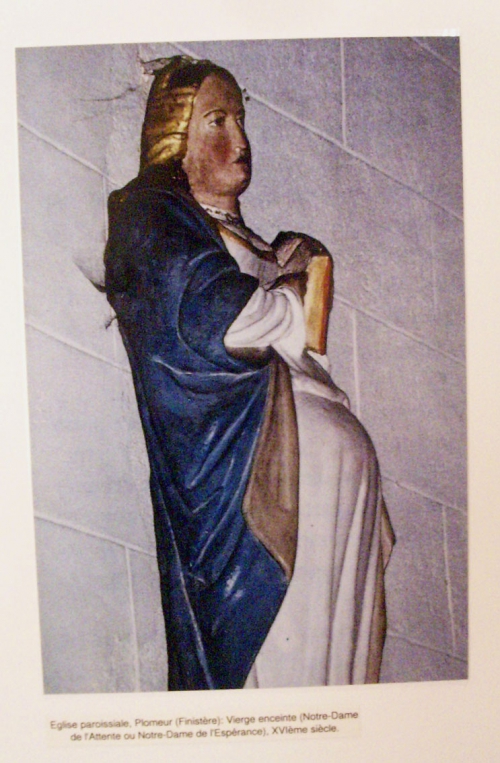
Chissey-sur-Loué
Situated in the north-eastern Jura department, in the church of St Christophe, this unusual 18th century virgin is transparent so we can see Jesus. Note her long hair. She’s carved in stone and is 90cm high. The church is open all day if you wish to visit.
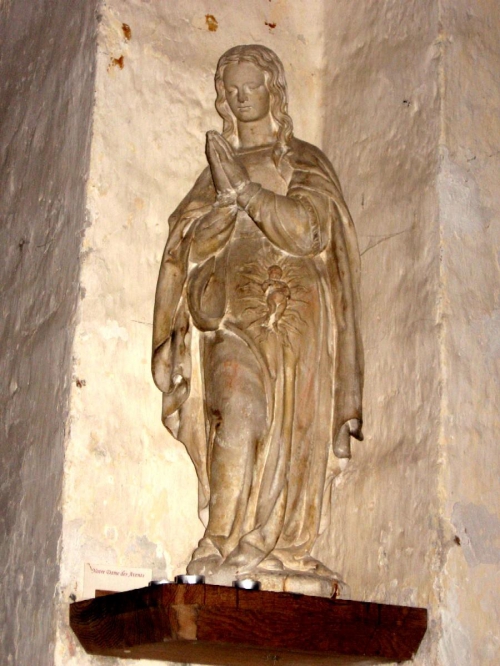
Oulchy-le-Château
This village in Picardie suffered dreadfully during the first world war, and is full of statues of soldiers. In the church is another long-haired “transparent” Virgin.
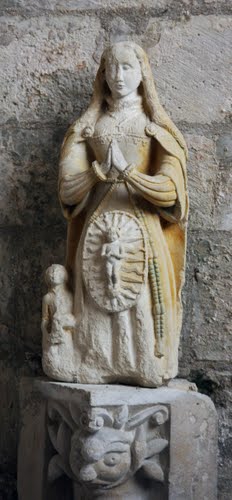
Arcachon
The chapel in this seaside town overlooking the Atlantic, started life as a monastery and was restored in 1993. The Vierge de l'Avent was donated by the mother house of the Daughters of Charity in Paris.
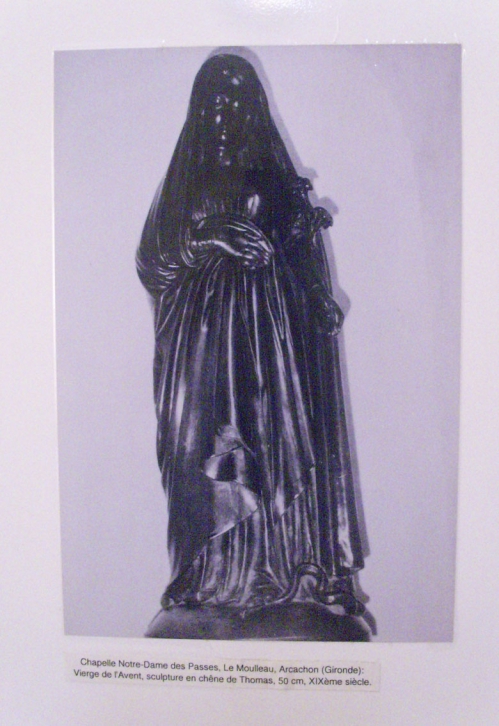
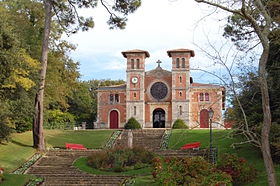
Belpech
This small town with a huge church, probably once fortified, is situated between Carcassonne and Toulouse. Belpech is very old, it was known in Celtic times, and is named after the God Belenos. “Pech” means hill in the Occitan language. A chateau was built there in the 10th century, now only the tower remains, and it was an important town in the times of the Crusades - against the Cathars presumably. At its foot was a monastery dedicated to Notre Dame de Garnac; you can see a church wall. It is a very religious town, with a second church, another ruined chapel and many wayside crosses. In the graveyard chapel there is a statue of Mary Magdalene, and a stained glass window to her in the church of St. Sernin.
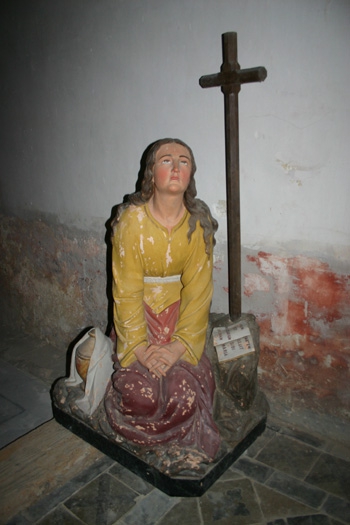
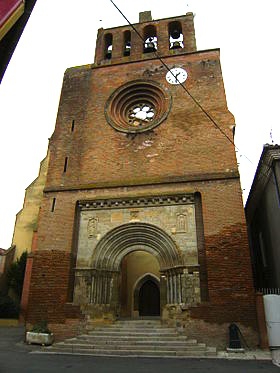
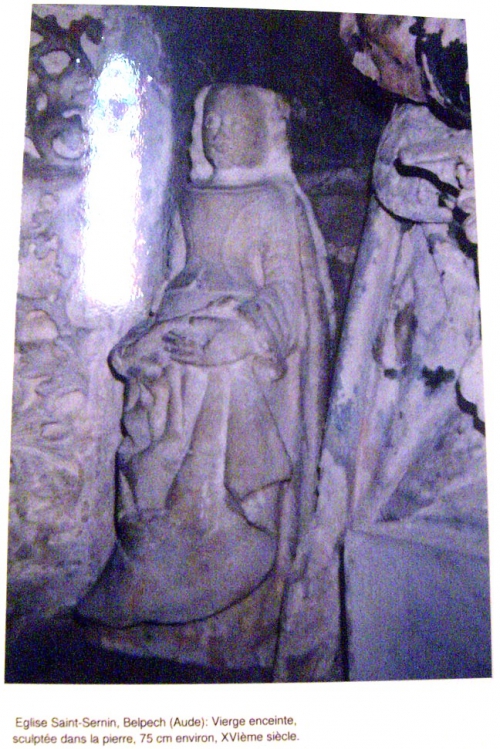
Laroque des Albères
In the Pyrenées-Orientale, Laroque des Albères was formed in the 9th century or earlier, for the Bishop of Elne was given the “two small possessions” of Saint Felix and Saint Julien, both popular Spanish saints in 834. These were two monasteries, or “rural retreats,” attached to the “Villa Torrente” , as it is known today, a rural hamlet or perhaps a large working farm.
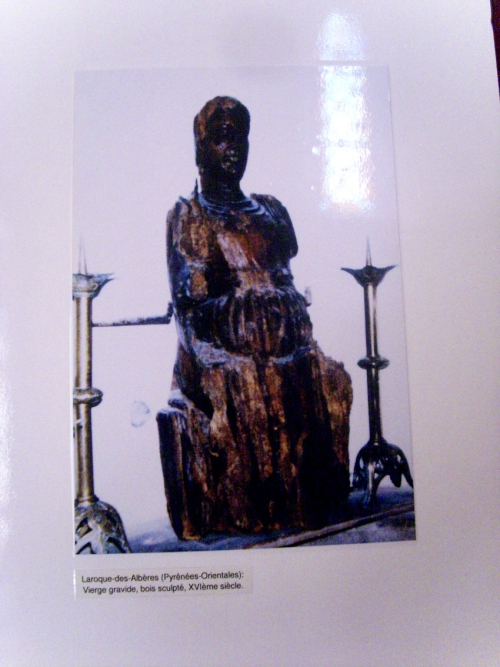
Prades
At the foot of Canigou mountain, Prades by the Têt river is the capital of the Conflent region in Catalonia. In 1364 the town built a hospital whose chapel was dedicated to Notre Dame de l'Espérance - Our Lady of Hope. In there is the gilded wood statue from the 17th century. The hospital is now huge and modern, but the chapel remains unchanged beside it.
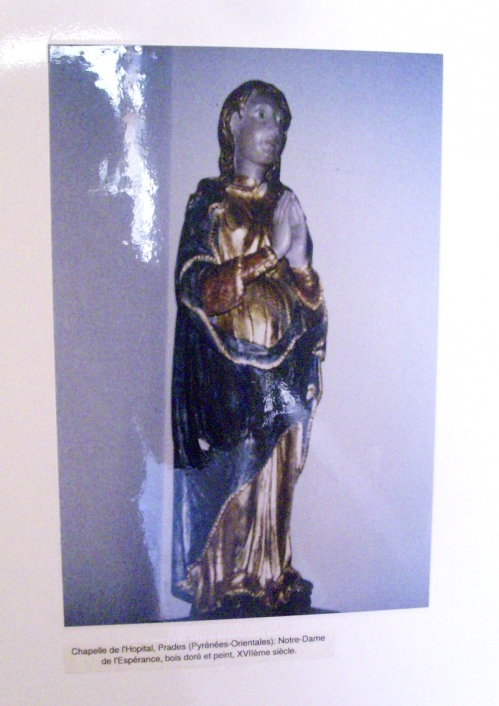
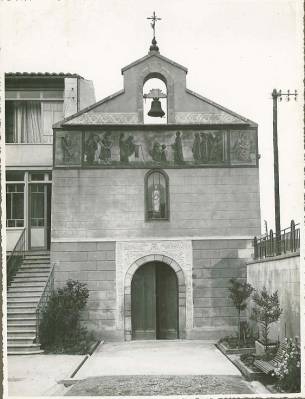
Perpignan
St Jacques’ church is the largest and most famous in Perpignan after the cathedral and they have a whole wall dedicated to another Notre Dame de l’Espérance. In a parish magazine published at Advent, it said; In the ancient Visigothic rite, as today still in oriental rites, the annunciation is remembered on the 17th December, eight days before Christmas. This date has remained a Marian festival, under the title of Our Lady of Hope; the Virgin Mary who is expecting the coming into being of the promise of the angel.
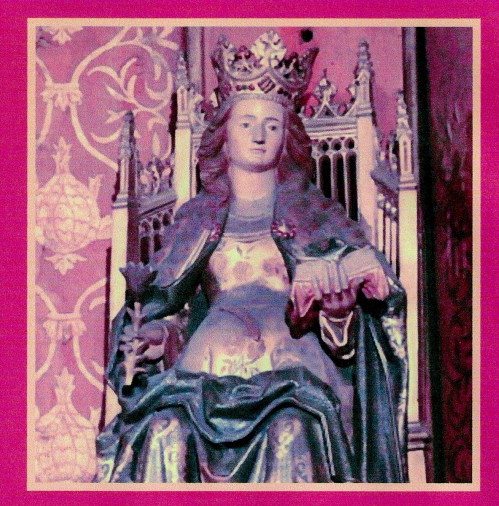
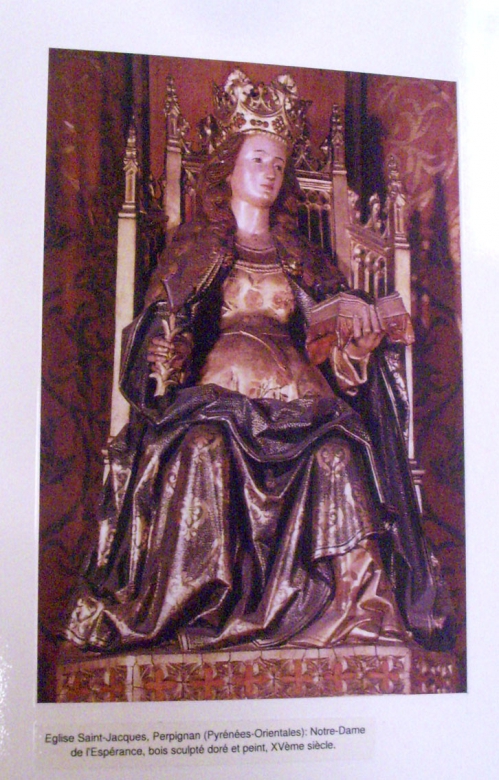
Here Mary is very regal and quite unlike the young girls with loose hair in the other statues.
The coming into being of the promise of an angel - I like that. Maybe it refers to all babies.
The village of Cucugnan is part of the route that Mary Magdalene and Jesus travelled, as I describe in my book, The Sacred Journey. Buy the book here.
Inscrivez-vous au site
Soyez prévenu par email des prochaines mises à jour
Rejoignez les 261 autres membres

